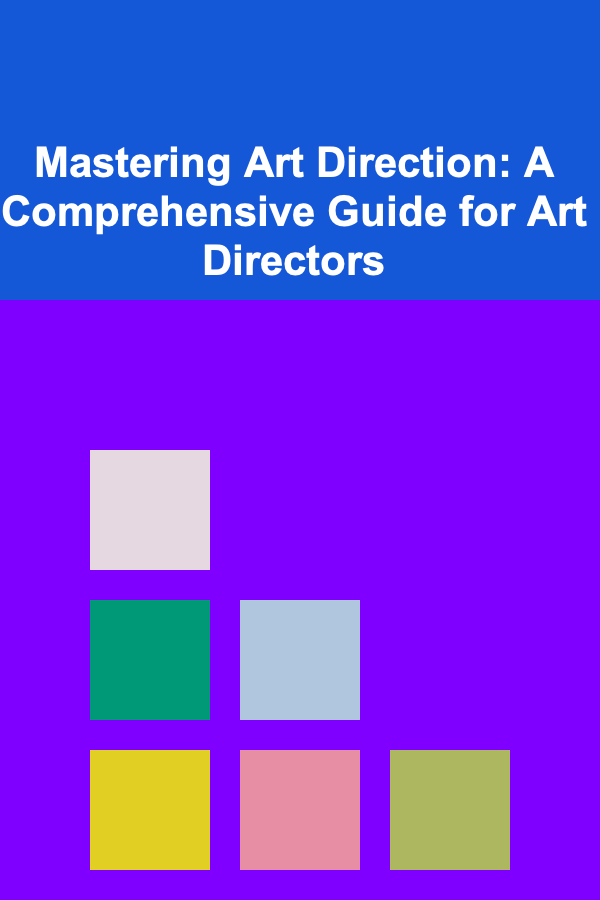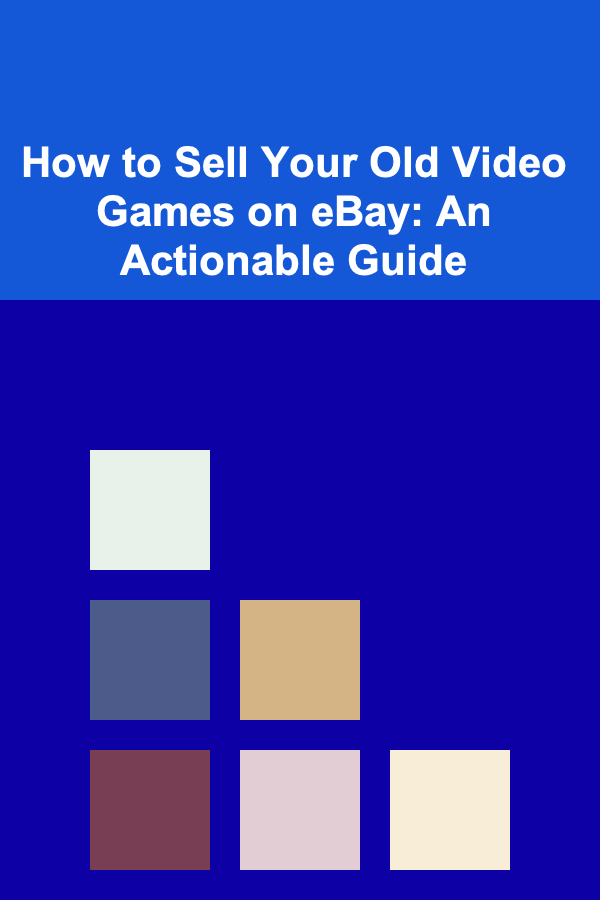
Mastering Art Direction: A Comprehensive Guide for Art Directors
ebook include PDF & Audio bundle (Micro Guide)
$12.99$8.99
Limited Time Offer! Order within the next:

Art direction is a critical component of visual communication, playing a key role in the way creative projects come to life. Whether in advertising, publishing, fashion, film, or digital media, an art director is the driving force behind the visual aspects of a project, ensuring that every element aligns with the overall concept and communicates the desired message. In this guide, we will explore the essential skills, principles, and strategies that an art director must master to create compelling and effective visual experiences.
Understanding the Role of an Art Director
An art director's primary responsibility is to oversee the visual style and imagery in various media formats. This includes everything from print advertisements and brand identity systems to websites, film scenes, and social media campaigns. The art director's role involves collaboration with other creative professionals, such as graphic designers, photographers, illustrators, copywriters, and editors, to bring a concept to life in a cohesive and aesthetically pleasing way.
Key Responsibilities:
- Concept Development: Work closely with clients and creative teams to develop and refine the visual concept based on the project's objectives and target audience.
- Design Direction: Set the tone for color schemes, typography, imagery, and overall visual aesthetics.
- Collaboration: Lead and guide designers, photographers, and other visual artists in executing the concept while maintaining the consistency and vision of the project.
- Quality Control: Ensure that the final deliverables meet the standards of the project in terms of quality, creativity, and alignment with the client's brand or objectives.
- Presentation: Present ideas to clients, executives, or stakeholders and make necessary adjustments based on feedback.
The art director's role is dynamic and requires both creative vision and strong leadership to steer a project through its visual journey.
Building a Strong Foundation: Core Skills for Art Directors
To excel in art direction, one must possess a diverse set of skills that blend creativity, technical expertise, and communication. Here's a breakdown of the core competencies every art director should develop:
Creative Vision
Art direction is about translating ideas into visual concepts. Whether it's a simple logo or a complex visual campaign, an art director must have the ability to conceptualize how the design elements can effectively communicate the message.
- Inspiration: Draw inspiration from various sources such as art history, nature, fashion, architecture, and even other media like film or music.
- Originality: Strive to create unique designs that stand out from the competition. Originality helps a project gain attention and connect with audiences.
Typography and Layout Design
The way text and images are arranged plays a huge role in the overall look and feel of a project. Understanding typography principles, including font pairing, spacing, hierarchy, and alignment, is crucial for any art director.
- Font Selection: Choose fonts that align with the project's tone, audience, and purpose. The right font can elevate a design, while the wrong one can make it feel unprofessional.
- Grid Systems and Composition: Use grids to maintain balance and consistency in layouts. Effective use of composition guides helps create harmony and clarity within the design.
Color Theory
Color sets the mood and tone of a project. Understanding color psychology and how to use colors effectively is an important skill for art directors.
- Emotional Impact: Colors convey emotions. For example, red can evoke excitement or urgency, while blue suggests calm or professionalism.
- Color Harmony: Create visually pleasing color palettes by understanding the relationships between colors (e.g., complementary, analogous, triadic schemes).
- Branding Consistency: For branding projects, an art director must ensure that the colors used align with the brand's existing color identity.
Communication and Collaboration
An art director must be an effective communicator. Whether presenting concepts to clients, working with designers, or providing feedback to photographers, clear and concise communication is essential.
- Client Relations: Build and maintain strong relationships with clients by understanding their needs and providing creative solutions that meet their objectives.
- Feedback and Direction: Provide constructive feedback to team members and guide them in executing your vision. A good art director knows how to motivate their team while ensuring they stay on track.
Attention to Detail
An art director needs an eye for detail, as even the smallest design decisions can have a significant impact on the overall aesthetic and effectiveness of the project.
- Pixel Perfection: Whether it's adjusting the kerning of a letter or aligning elements to a grid, small details matter.
- Consistency: Ensure that all elements in the project, from typography to color schemes, remain consistent throughout.
Mastering the Process of Art Direction
Art direction is not just about creative instincts; it's about following a well-structured process that ensures the visual vision comes to life effectively. Here are the key steps in the art direction process:
1. Concept Development
The art direction process begins with the development of a solid concept. This phase involves understanding the project's objectives, the target audience, and the overall message. A successful concept should be both creative and strategically aligned with the goals of the project.
- Research: Understand the client's brand, competitors, and industry. Research the target audience to identify what resonates with them.
- Brainstorming: Collaborate with the team to brainstorm ideas and explore different visual directions. Use mood boards and visual references to communicate the intended aesthetic.
2. Visual Strategy
Once the concept is in place, the next step is to develop a visual strategy that will define the look and feel of the project. This includes deciding on the color palette, typography, image styles, and overall design direction.
- Mood Boards: Create mood boards to visually represent the mood, tone, and style of the project. This serves as a reference for the design team.
- Style Guides: Establish clear guidelines for the design elements, including font choices, color palettes, and image treatments, to ensure consistency across the project.
3. Design Execution
At this stage, the art director works closely with graphic designers, illustrators, and other creatives to bring the visual strategy to life.
- Design Layouts: Start with rough sketches and wireframes before refining the layouts. The design team will iterate on different options to refine the concept.
- Photography and Illustration Direction: Guide photographers and illustrators in achieving the right look and style that aligns with the vision.
4. Refinement and Client Feedback
Once the initial designs are ready, the art director presents them to the client or stakeholders for feedback. This is a crucial phase where revisions and adjustments are made.
- Incorporate Feedback: Listen to the client's feedback and make necessary changes while maintaining the integrity of the original concept.
- Polishing: Fine-tune the design, ensuring all details are perfect, from color corrections to alignment and typography adjustments.
5. Final Production
After all revisions are made, the project is ready for final production. This involves preparing files for print, web, or digital use, ensuring all specifications are met.
- File Preparation: Ensure that all files are correctly formatted for the intended medium. This includes exporting files for web, print, and social media.
- Quality Control: Double-check everything for errors before the final handoff to ensure that the project is polished and professional.
Leading the Creative Team: Effective Team Management
Art directors often lead a team of creatives, including designers, illustrators, photographers, and sometimes copywriters. The ability to manage and inspire this team is essential for success.
Provide Clear Direction
Art directors must communicate the vision and objectives clearly to their team. Provide detailed briefs and set expectations from the beginning, so everyone is aligned on the project goals.
Foster Collaboration
Encourage collaboration and open communication. Design is a team effort, and art directors should create an environment where ideas flow freely and team members feel comfortable sharing their input.
Inspire Creativity
A good art director inspires their team to push boundaries and experiment with new ideas. Encourage innovation and be open to trying different approaches to achieve the best results.
Time Management and Delegation
Manage deadlines and delegate tasks efficiently to ensure that each team member can focus on their strengths. A successful art director knows how to balance workloads and ensure that the project is completed on time without sacrificing quality.
Evolving as an Art Director: Staying Current with Trends
Art direction is an ever-evolving field, with new trends, technologies, and tools emerging regularly. It's essential for art directors to stay updated and continue developing their skills.
Follow Design Trends
While it's important to stay true to a brand's identity, art directors should keep an eye on current design trends to ensure their work feels fresh and relevant. This could include new approaches to typography, color schemes, or illustration styles.
Experiment with New Tools
As digital tools and software continue to evolve, art directors should familiarize themselves with the latest design software and techniques. Embrace new tools that streamline workflows, enhance creativity, and improve efficiency.
Seek Continuous Learning
Attend design conferences, webinars, and workshops. Participate in creative communities and seek feedback from peers. Constant learning will ensure that an art director remains at the top of their game.
Conclusion
Mastering art direction requires a unique blend of creativity, technical skill, and leadership. By developing a deep understanding of design principles, honing communication and collaboration skills, and following a structured process, art directors can create visually compelling and effective projects. The ability to guide and inspire a creative team is essential, and staying current with industry trends ensures that art directors remain adaptable and innovative in an ever-changing field. With a passion for design and a commitment to excellence, art directors can elevate their craft and create lasting, impactful visual experiences.

How to Choose the Right Furniture for Home Staging
Read More
How to Create a Compelling Call-to-Action on a One-Page Website
Read More
How to Secure Your Windows and Doors Against Intruders
Read More
How to Sell Your Old Video Games on eBay: An Actionable Guide
Read More
Choosing Ethical and Sustainable Fashion: A Comprehensive Guide
Read More
How to Plan a Prenatal Fitness Class
Read MoreOther Products

How to Choose the Right Furniture for Home Staging
Read More
How to Create a Compelling Call-to-Action on a One-Page Website
Read More
How to Secure Your Windows and Doors Against Intruders
Read More
How to Sell Your Old Video Games on eBay: An Actionable Guide
Read More
Choosing Ethical and Sustainable Fashion: A Comprehensive Guide
Read More